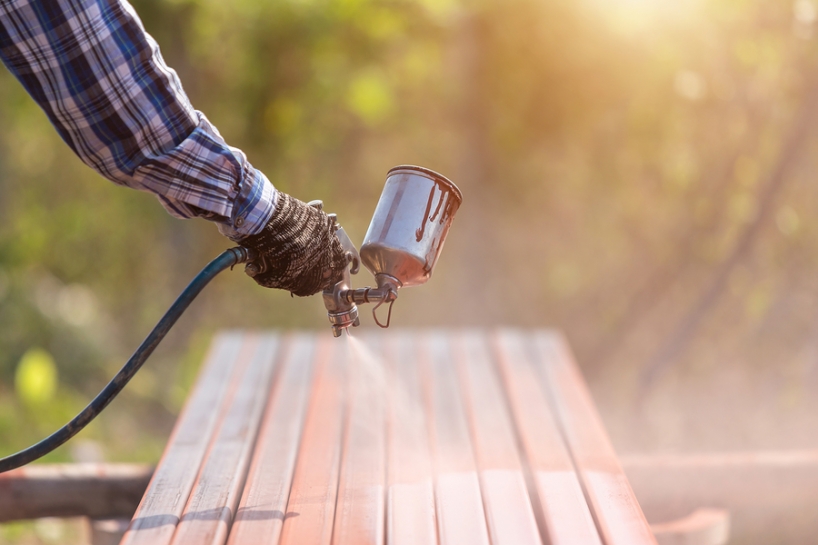
June 15th, 2020 by
If you have only ever used a brush or roller to apply paint then a paint sprayer is a game-changer. The biggest advantage is the time it saves but it can also give you a more even finish, with no brush marks, and allows you to get into small, hard to reach areas – great for ornate detailing and tight corners. Paint sprayers are perhaps more commonly associated with spraying outdoors, such as fences or garden furniture but they can equally be used indoors for walls, ceilings, and even gloss work.
If you’re not used to working with this kind of equipment, there are a few things you need to know so here are our top tips for getting to grips with a paint sprayer:
Preparing
 Paint sprayers can be used with a wide variety of paints, from emulsion and stains to gloss, varnish and even wood oils. However, it is really important to check the paint manufacturer’s instructions for use in a sprayer as some may have to be diluted
Paint sprayers can be used with a wide variety of paints, from emulsion and stains to gloss, varnish and even wood oils. However, it is really important to check the paint manufacturer’s instructions for use in a sprayer as some may have to be diluted- Always give your paint a good stir to avoid clogging the nozzle. Some will need to be strained first
- The nature of creating a spray means that while most will be directed towards the item you are painting, some will disperse more widely. That is why it’s so important to cover anything in the space that you don’t want to get paint on. Always wear old clothes that you don’t mind getting messy and it’s advised to wear some kind of goggles to protect your eyes
- If spraying anything with gaps, such as a fence or trellis, obviously some paint will go through so just make sure anything behind is covered
- If painting outdoors, be aware that any breeze can disperse the paint spray further
- If painting indoors, make sure the space is well ventilated so the fumes of the paint can escape. A face mask is advised
- Prepare any surfaces that you are spraying just as you would if painting using any other technique. This should involve cleaning the surface down and sanding where appropriate. Some may require a primer
- Make sure you have cleared the area of any trip hazards or objects that may get in your way. Remember that you will cover a much larger area faster than using a brush so where you may usually just move items as you work around them, with a paint sprayer you’ll want to keep moving without having to stop
- Don’t use a paint sprayer if the temperature is below 7°, as the paint would take too long to dry and increases the risk of dirt or insects sticking to it, or above 24° as the paint would dry too quickly and may not bond properly
Practising
- If using a paint sprayer for the first time, you have not used it for a while, or you are using a different type of paint to that which you are accustomed to, always practice first on a piece of paper or cardboard
- Many paint sprayers offer different spray patterns, such as round, horizontal and vertical, and each will work best for different purposes. To get to grips with these, practice just with water to start with and spray on an outdoor wall or garage door to see how they look before committing yourself
Applying
 On areas with corners and crevices, such as interior walls, cut in from the edges just as you would with a brush, then work across the main area
On areas with corners and crevices, such as interior walls, cut in from the edges just as you would with a brush, then work across the main area- Maintain a consistent distance from the surface that you are spraying as the closer you are, the more paint coverage you will achieve (if you’re too close, you’ll apply too much paint and it may drip)
- Start with light coverage and then go over if required. It’s much easier to top up a thin layer of paint than try to fix an overpainted area
- Keep the gun moving in long, straight strokes. If you move too slowly, more paint will be applied and it may run
- Keep moving along the surface rather than standing still and fanning the nozzle like a machine gun. This will apply the paint more evenly
- Overlap each pass slightly to avoid a stripy finish
- Have a brush or sponge to hand so you can touch up as you go while the paint is still wet
Using a paint sprayer just takes a little getting used to though tools like Mylek’s 700w Paint Sprayer Kit are very user friendly and even comes with a shoulder strap to allow you to carry it more easily for an even finish. Once you use one, we doubt you’ll go back to a brush!
Comments
Leave a reply
Your e-mail address will not be published. All fields are required



